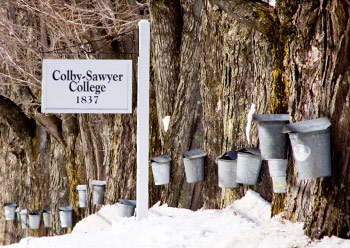
Sue's Sugar House Creates Sweet Opportunity for Applied Science and Community Engagement in Maple Sugaring
Sue's Sugar House is the new name for the old stone well house in front of the Susan Colgate Cleveland Library/Learning Center, and the place is hopping as the sap in maple trees around campus starts running. One professor's vision and one alumna's generosity, with contributions of creativity and effort from individuals across campus and the community, have combined to create a rock-solid, tangible applied science project that will benefit students for years to come – a maple sugaring operation on campus offered as a course called The Science of Maple Sugaring.
Though expected to produce about 20 gallons of syrup, the project is about much more than the sweet stuff in those classic bottles of breakfast happiness. It is, more than anything, a community effort that has gotten people on and off campus just plain excited.
“This project allows students to participate in the sugaring process and learn about the various aspects of the production, including the history of sugaring, the forest management, the technological advances in equipment, the science behind sugaring, the business aspects, and the fun of the process,” says Assistant Professor of Natural Sciences Nick Baer. “While I do want us to produce maple syrup, the goal of the course is not about maximizing production but rather integrating a traditional activity into the curriculum and infusing learning into an applied project that is interesting and exciting. While the students in the class participate directly in the production, others across campus are involved in different aspects: Graphic Design and Creative Writing students are helping to create the labels; Communications Studies students are working on an audio documentary; Business Administration students will market however much extra syrup we have after satisfying all the college and project obligations.”
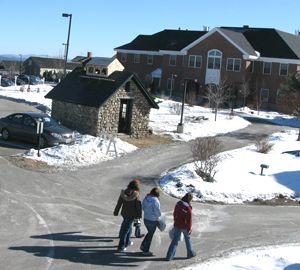
Applied Science Involves Students in Hands-On Learning, Creates Community
It all started three years ago when Professor Baer wanted to find an applied science project with which he could involve students. Interested in sugaring since he spent time as a boy on a New York farm, Professor Baer found it a good fit with his own love of hands-on learning. With his spring ecology and environmental issues classes, he tapped the trees on campus and collected the sap. His students quantified the differences in sugar content and sap production by species, comparing sugar, red and Norway maples; considered the trees' location in sun or shade; and investigated the science of making syrup.
For the first two years, Professor Baer and the students worked in partnership with the Clough family of New London, taking the sap the students collected to the Clough's century-old sugar house near Pleasant Lake where they learned the history of sugaring. Bill Clough is a member of the Colby-Sawyer Board of Trustees, and his brother John owned New London landmark Spring Ledge Farm for 30 years.
When Professor Baer approached Academic Vice President and Dean of Faculty Deborah Taylor with the idea of moving the maple sugaring project to campus, he got the go-ahead to pursue the project.
“I then talked with folks in Advancement to see if there was an opportunity to find funding from alumni for a project like this, because we couldn't proceed without funding,” says Professor Baer. “They were really supportive so I wrote a proposal.”
Major Gifts Officer Beth Camp '92 worked with Sue Barto Monks '60, who stepped forward to offer her support of the sugaring project. Sue says she's always enjoyed visiting sugar houses and appreciates the simplicity and purity of this unique New England tradition. Sue, who grew up in Connecticut and earned her Medical Secretary degree from Colby Junior College, feels the college gave her a wonderful education which has shaped her life in several ways. She has remained a loyal and active alumna who, over the last 50 years, has enjoyed watching the college adapt and evolve. Today, she still values the strong reputation the college has always enjoyed.
A Gift Makes the Difference
In offering her generous support to the sugaring project on campus, Sue hopes that many students will learn the process of sugaring and be inspired to sugar on their own long after they leave the college.
“Sugaring fits nicely at the college since it provides the students with another opportunity for hands-on and experiential learning,” says Sue. “Additionally, this is a wonderful way to reuse an existing building and make it functional.”
With Sue's support secured, Vice President of Administration Doug Atkins set the wheels in motion for building permits, and Facilities installed a new cement floor and wiring for electricity in the well house that had sat empty for years. During renovations, writing on the wall revealed that in 1983, before the building was part of the college, someone else had spent many hours boiling sap and recorded their efforts. This tally of hours and gallons has now been preserved under plexiglass.
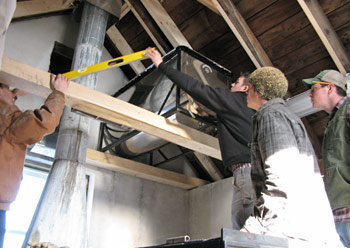
Meanwhile, Professor Baer, with the help of a UNH intern and Environmental Studies colleagues Leon-C. Malan and Laura Alexander, tagged and cut invasive Norway maples to burn in the future sugar house. Pam Spear, director of the college's Baird Health and Counseling Center, and her husband, Assistant Professor of Business Administration Bill Spear, donated split pine to bring the stockpile to about four cords with plenty of time to dry. Professor Alexander's family got involved by donating heavy equipment and building custom racks to hold the firewood.
As the well house underwent renovations, including a new chimney and cupola to release steam when boiling is in progress, Professor Baer and his sugar brigade started collecting equipment to fill the small building.
“Bill Clough has been a terrific resource for this project,” says Professor Baer. “He sees the value of it and it's been great working with him. The two of us drove up to Maine in his truck to pick up a nice canning unit, which was donated to the college on Bill's behalf. Tim Cook in Facilities, who has sugared all his life and has a sugar house, has been another great resource in figuring out what we need and what's reasonable, and he donated the two oak beams in Sue's Sugar House. We ended up finding a basically brand-new evaporator in the middle of New York State, and after talking to my consultants – Bill Clough and Tim Cook – Leon and I borrowed John Clough's trailer to go check it out. It was in perfect shape, so we loaded it up and stored it in the basement of Colby Farm. Bill Clough volunteered to donate buckets to the project, so we just had to buy all the filters, bottles and taps. ”
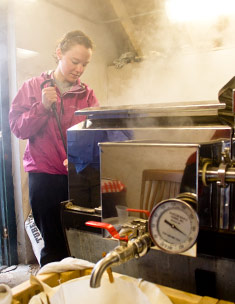
Student Interest and Appreciation Run Strong
Interest in the sugaring project has been intense among students as well as community members; 38 signed up for the class that enrolled just 10.
“Every student in the class has been committed to the course, and the maple sugaring project,” says Professor Baer. “We're going to do this every year, and Sue Barto Monks was the catalyst to make it all happen.”
Dave Rosso '10 and Michael Nigro '10, both sport management majors from Vermont, have seen sugaring in action from near and far perspectives.
“I've sugared for six years at an established sugar house and was really excited to help create a new one from scratch. I have used many different skills in this class, from carpenter and math skills to physical labor and the skills I learned from sugaring in the past,” says Rosso. “My favorite part of the course has been seeing everything come together and finally getting to boil. It is really awesome how the process works and to know you worked hard for it makes it that much better. I think that it is totally awesome that an alumna donated money to make this happen. It makes me want to give back to the school after I graduate.”
Nigro, whose family's property is tapped by a friend, says that growing up in New England, tapped trees and sugar houses are part of the landscape, but that he's always been interested in learning how sugaring is actually done.
“This course has been a great learning experience and I hope I can continue sugaring in coming years,” says Nigro. “I am very humbled to know that an alumna was willing to give a generous donation to be able to make this happen. For sure, this experience has been an adventure.”
Anthony Marrone '10, a ceramics major from Tamworth, N.H., with no previous sugaring experience, agrees, saying, “It is nice to know that alumni care about this school and want to make a difference to our college experience. This is probably the busiest semester I have had and I still feel like this project has been a wonderful addition to my college education. The material is interesting, the professor's working very hard, and I am having fun throughout the process. I especially like the atmosphere of the sugar house during a boil – the steam is intense and the smell is amazing. It is a nice way to relax and create a final product after the process of collecting sap is complete for the day.”
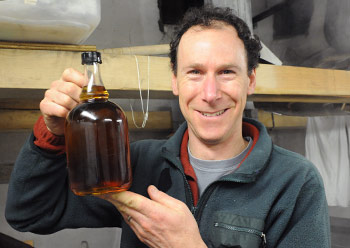
With the sugaring season in full swing for another couple weeks, Sue's Sugar House has boiled down enough sap to produce about 13 gallons of syrup so far. Some of the syrup produced at Sue's Sugar House will be given to Colby-Sawyer President Tom Galligan, members of the President's Alumni Council, and to Alumni Relations and Annual Giving to distribute as thank yous for supporting the college.
Sue Barto Monk's favorite way to use maple syrup? On French toast, or the German apple pancakes that her husband makes. Professor Baer likes to pour it on pancakes and waffles, and use it in his breakfast bread recipe. Each student in the class will get some syrup, as well, as a reminder of their hard work and rare opportunity to learn the science of maple sugaring.
“Professor Baer has been awesome during this experience. His excitement, enthusiasm, and hard work really made this course fun and interesting,” says Rosso. “My friends think it is really cool that I have the opportunity to take a course like this because not many people at other colleges do.”
Photos by Anthony Marrone '10, Visiting Assistant Professor of Humanities David Reed and Kate Dunlop Seamans


